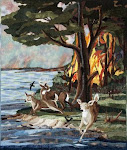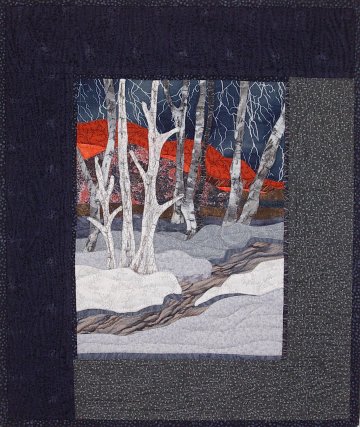As a consequence of volunteering at my local museum and working with its quilt collection, I like to roll my quilts on cardboard tubes that have been prepared following museum guidelines.

I glean hard cardboard tubes from a local fabric store or carpet outlet. For smaller quilts, use the tubes from waxed paper or plastic food wrap. The first step is to wrap the tube with aluminum foil because the foil serves to trap and contain any gases emitting from the cardboard. After wrapping, tuck the foil into the tube ends to hold in place. Follow by covering the foil with leftover batting to pad the tube.
Pre-washed muslin is used to cover the padded tubing. I quickly hand sew a seam using an overcast stitch, the length of the tube to secure the muslin covering. Others like to use a strip of fusible to close this seam, but I’m concerned with the fusible breaking down causing the sticking chemical to permeate the muslin covering and contaminate the quilt. Simple cloth ties are used to hold the rolled quilt in place. A long cloth bag is constructed into which the rolled quilt is slipped. And, yes, I store more than one quilt on a tube.
To aid the quick identification of quilts once hidden away in cloth bags, I use hanging tags that are purchased from an office supply store. Each tag has a reinforced hole with a string for attaching to the bag. I write the quilt names in pencil on the tag and pin it to the bag so I can easily read the bag’s contents. I ten
 d to switch quilts from one roll to another over time, so I use pencil to write the information on tags. It's easy to erase pencil and I’m Scottish enough not to write new tag each time I pull a switcher-roo.
d to switch quilts from one roll to another over time, so I use pencil to write the information on tags. It's easy to erase pencil and I’m Scottish enough not to write new tag each time I pull a switcher-roo. Next posting, Hanging Bags for Quilts.








.jpg)


